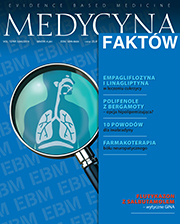Why the valproic acid has become a solid basis for the treatment of epilepsy – patients profiles Review article
Main Article Content
Abstract
Pharmacotherapy is the primary form of epilepsy treatment. The main determinant of the effectiveness of treatment is the adaptation of the antiepileptic drug to the type of epileptic seizure. The study is an overview of several clinical situations taking into account the most important profiles of patients who should use valproic acid.
Article Details
How to Cite
Nagańska, E. (2019). Why the valproic acid has become a solid basis for the treatment of epilepsy – patients profiles. Medycyna Faktow (J EBM), 12(3(44), 209-213. https://doi.org/10.24292/01.MF.0319.4
Issue
Section
Articles
Copyright © by Medical Education. All rights reserved.
References
1. Glauser T.A., Cnaan A., Shinnar S. et al.: Childhood Absence Epilepsy Study Team. Ethosuximide, valproic acid, and lamotrigine in childhood absence epilepsy: initial monotherapy outcomes at 12 months. Epilepsia 2013; 54(1): 141-155. DOI: 10.1111/epi.12028.
2. Jędrzejczak J., Majkowska-Zwolińska B., Ryglewicz D. et al.: Zalecenia Polskiego Towarzystwa Epileptologii dotyczące leczenia napadów padaczkowych u dorosłych. Aktualizacja. Journal of Epileptology 2019; 27 (supl. 1): 5-12.
3. Ma X., Zhang Y., Yang Z. et al.: Childhood absence epilepsy: Electroclinical features and diagnostic criteria. Brain Dev. 2011; 33(2): 114-119. DOI:10.1016/j.braindev.2010.02.004 .
4. Gürer R., Aydın Ş., Özkara Ç.: Outcomes of low-dose valproic acid treatment in patients with juvenile myoclonic epilepsy. Seizure 2019; 70: 43-48. DOI: 10.1016/j.seizure.2019.06.021.
5. Tomson T., Marson A., Boon P. et al.: Valproate in the treatment of epilepsy in girls and women of childbearing potential. Epilepsia 2015; 56(7): 1006-1019. DOI: 10.1111/epi.13021.
2. Jędrzejczak J., Majkowska-Zwolińska B., Ryglewicz D. et al.: Zalecenia Polskiego Towarzystwa Epileptologii dotyczące leczenia napadów padaczkowych u dorosłych. Aktualizacja. Journal of Epileptology 2019; 27 (supl. 1): 5-12.
3. Ma X., Zhang Y., Yang Z. et al.: Childhood absence epilepsy: Electroclinical features and diagnostic criteria. Brain Dev. 2011; 33(2): 114-119. DOI:10.1016/j.braindev.2010.02.004 .
4. Gürer R., Aydın Ş., Özkara Ç.: Outcomes of low-dose valproic acid treatment in patients with juvenile myoclonic epilepsy. Seizure 2019; 70: 43-48. DOI: 10.1016/j.seizure.2019.06.021.
5. Tomson T., Marson A., Boon P. et al.: Valproate in the treatment of epilepsy in girls and women of childbearing potential. Epilepsia 2015; 56(7): 1006-1019. DOI: 10.1111/epi.13021.

